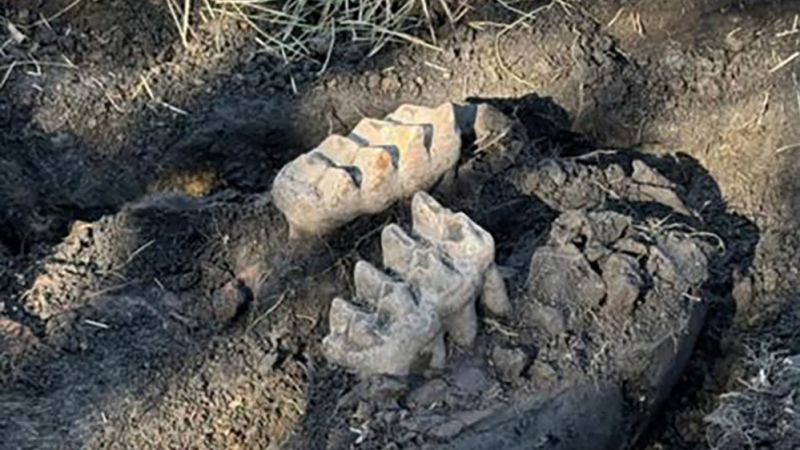In a remarkable discovery, a complete mastodon jaw has been unearthed from the backyard of a house in New York, as confirmed by the New York State Museum. This significant event took place in Orange County, located approximately 60 miles north of New York City. The jaw, along with a piece of toe bone and a rib fragment, was excavated by specialized teams from the New York State Museum and the State University of New York Orange, following a curious observation by the homeowner. While tending to his property, he noticed “two unusual teeth concealed by plant fronds,” prompting him to investigate further.
The homeowner, who has not been publicly named, expressed a sense of excitement and anticipation upon discovering the unusual teeth. “When I found the teeth and examined them in my hands, I knew they were something special and decided to call in the experts,” he stated in a news release from the museum. His instinct to reach out for professional assistance not only led to the excavation of the mastodon remains but also highlighted the potential historical significance of the find. “I’m thrilled that our property has yielded such an important find for the scientific community,” he added, reflecting the pride many feel in contributing to the collective understanding of prehistoric life.
This discovery marks the first recorded find of its kind in New York state in over a decade. According to data from the museum, more than 150 mastodon fossils have been recovered across the state, with approximately one-third of those concentration in Orange County. The region has thus been designated as a “hotspot” for such paleontological discoveries. The museum’s assertion emphasizes the area’s rich prehistoric past and its value for future research.
Dr. Robert Feranec, the director of research and collections at the museum and curator of ice age animals, weighed in on the significance of the mastodon jaw, stating that it provides a unique opportunity to delve deeper into the ecology of this impressive species. “This mastodon jaw provides a unique opportunity to study the ecology of this magnificent species, which will enhance our understanding of the Ice Age ecosystems from this region,” he commented. This perspective indicates that the research stemming from this find could reveal critical insights about the environment and lifestyle of mastodons during the Ice Age.
Mastodons themselves are fascinating creatures. They are viewed as distant relatives of modern-day elephants, roaming North America from approximately 3.75 million years ago until their extinction around 11,000 years ago. Adult mastodons typically stood between 8 and 10 feet tall, weighing as much as six tons. Their formidable size and lifestyle have intrigued scientists and the public alike, leading to extensive research into their behavior and ecology.
The extinction of mastodons has been attributed to several interrelated factors, predominantly competition for food resources, drastic climate change, and the pressures of overhunting by early human populations. Understanding these dynamics not only helps piece together the past but also provides valuable lessons for contemporary conservation efforts and human interaction with wildlife.
As for the mastodon jaw and accompanying bone fragments, they will soon undergo rigorous scientific analysis, which will entail processes including carbon dating and dietary reconstruction. These analyses are critical for accurately determining the age of the remains and understanding the mastodon’s diet or ecological role during its lifetime. The museum has announced that this significant historical find will be showcased to the public in 2025, allowing the community to engage with and learn from this rare glimpse into the Ice Age. The upcoming exhibit promises to be an educational milestone, further enriching the narrative of prehistoric life in North America.



